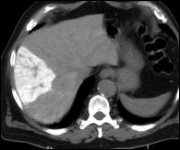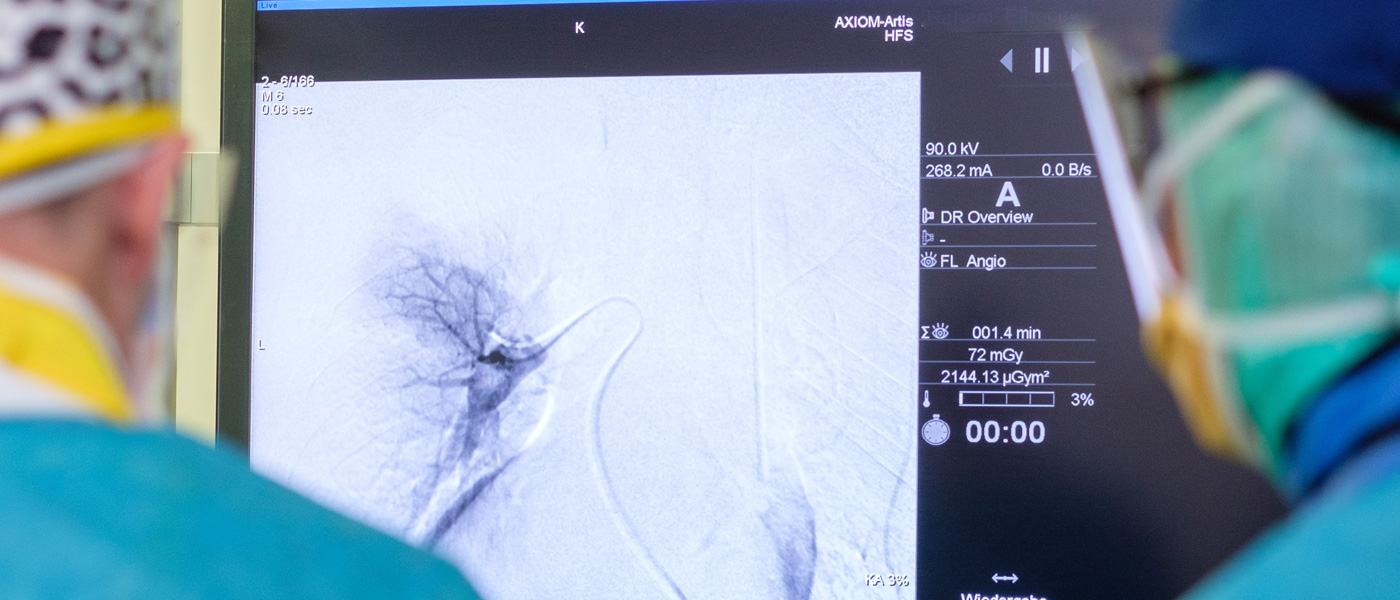The CT image taken after 24 hours of intervention shows a good emplacement of the chemoembolisat.
Transarterial Percutaneous Chemoembolisation (TACE)
Appointments: Intervention-Outpatient Section
Tel.: 069 / 6301-4736 -7277
Fax: 069 / 6301-7288
Contact person: Prof. Dr. T. Vogl, Dr. Zangos
Dear Patients,
On the following pages we would like to inform you about the Trans-Arterial percutaneous Chemo-Embolisation (TACE) offered at our institution.
On the following pages we have tried to summarised the relevant informations for you about Trans-Arterial percutaneous Chemo-Embolisation.
There are various forms of curative therapy available for the treatment of liver tumors. Among these are methods like Laser- Induced Thermotherapy (LITT) which is regularly performed at our institution, and other special local treatment methods ( e.g., alcohol instillation) in addition to surgical resection. Various systemic medications (chemotherapy) are used along with these procedures. "Transarterial Chemoembolization (TACE)" which is performed on a regular basis at our institution shows promising results in the treatment of liver metastases. The choice of therapy, combination of different medications and also the time of starting the therapy have not been standardized and are adapted to the individual patient requirements. In TACE, the knowledge of difference in blood supply to the tumor and liver tissue is used. Up to 75% of the normal liver tissue is perfused by the portal venous system and only 25% is supplied by arteries. On the contrary, liver tumors are supplied up to 95% by arteries. Hence chemoembolization of liver arteries lead to development of ischemic necrosis in the tumor region while the remaining normal liver tissue is spared by sufficient perfusion through the portal venous system.
Above all, application of chemotherapy through the major arteries into the liver arteries allows one to achieve a concentration 100 times higher than by systemic approach with only minimal adverse effects. The half-life of chemotherapeutic agent is increased by hours to weeks through the stoppage of blood supply.
Indications for Trans-Arterial Chemo-Embolization:
Indications for Transarterial Chemoembolisation:
- Unresectable (surgically or by laser induced thermotherapy) liver metastases and primary Livertumors diagnosed intraoperatively or morphologically using CT and MRI examinations.
- Not responding to systemic chemotherapy.
Criteria for transarterial chemoembolization:
Pre-conditions for Trans-Arterial Chemo-Embolisation:
- Normal liver vessel architecture with good perfusion of both liver lobes.
- Patent portal vein.
- No ascites.
- Good liver function.
- Good general condition of the patient.
Advantages of Trans-Arterial Chemoembolization:
- Associated with very little stress for the patient
- Complication-free Procedure with good quality of life
- Relatively shortened hospital stay (done on an outpatient basis)
- Reduction of tumour growth or reduction in tumour size
A female patient with liver metastases of ovarial carcinoma.
Patient with hepatocellular carcinoma (HCC).

Before the treatment a good visualisation and likewise localisation of the tumor is made with the help of our modern digital imaging machines like the MRI or CT so that the embolisat can be injected exactly in the tumour tissue.

After local anesthesia, a puncture is made into the femoral artery in the inguinal region. Doing this, a small femoral sheath is usually placed in the artery through which different catheters or guide-wires can be inserted.
The abdominal aorta with its various branches is visualized. Then a very small catheter (micro catheter) is passed through the liver artery into the artery supplying the tumor and the chemoembolization is performed.
The patients are given pain medications through infusion to prevent pain during the procedure.
The chemoembolization agent are usually composed of:
Mitomycin C or Gemcitabine or both combined (chemotherapeutic) in combination with Lipiodol and Spherex (blocks blood vessels).
The sensitivity of the liver tumor (chemosensitivity) to a particular chemotherapeutic agent can be tested before the procedure through a biopsy from the targeted liver lesion which helps to achieve better results with the mentioned treatment procedure.
At the end of transarterial chemoembolization and after removal of the catheters and femoral sheath, a pressure bandage is applied to prevent any complications in the inguinal region (e.g., haematoma). The patient is then placed for observation for about 6 hours during which possible complications can be diagnosed and treated.
To evaluate the success of the treatment and to rule out a complication, the patient undergoes a check MRI on the same day of chemoembolisation and likewise a CT follow-up on the following day without contrast agent.
Typically the chemoembolisation is done in 2-3 cycles at an internal of 4 weeks between the cycles but some cases may require more cycles depending on treatment success.
Female Contortionist in the widest MRI
Quelle: Dr. med. Nagy Naguib, Größe: 9,1 MB , Dauer: 01:43 min
Hinweis: Zum Betrachten dieses Assets benötigen Sie das Windows MediaPlayer-Plugin, das Sie hier kostenfrei herunterladen können.
